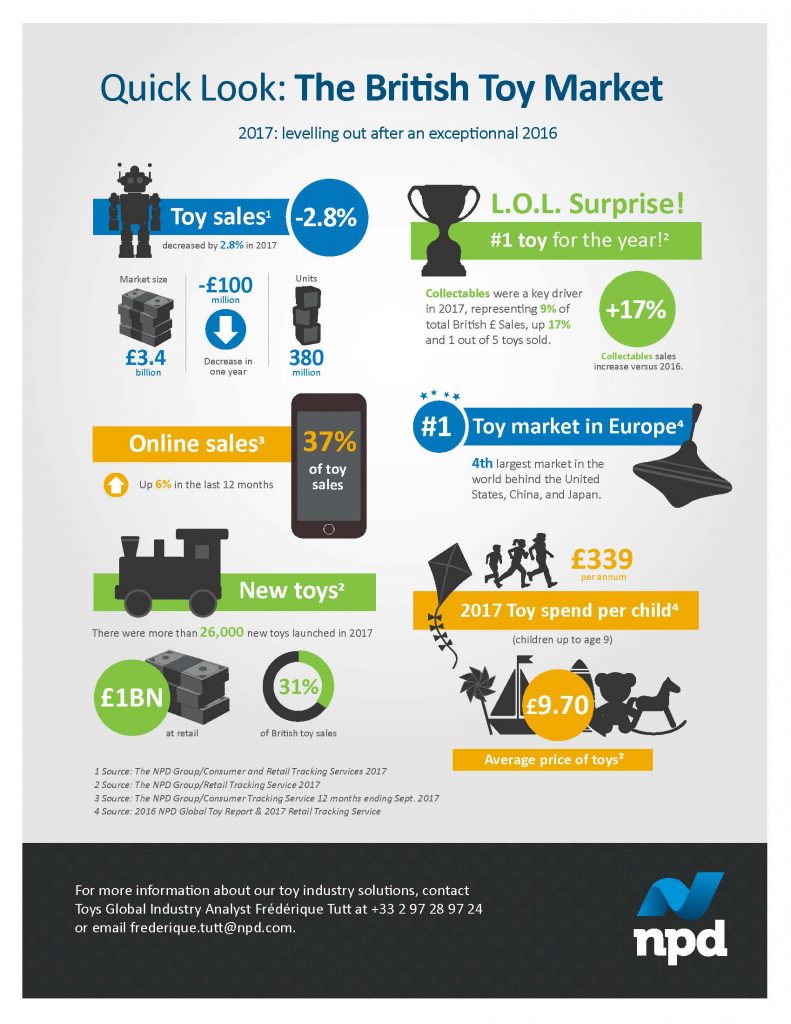UK Toy Market Decreases In 2017 Amid Concerns About Counterfeit Toys
This week saw the London Toy Fair take place and one aspect of the toy business that was a major discussion point was how the UK toy sales decreased by 2.8% in 2017 to £3.4bn. There are a number of factors that have contributed to this dip in the market, including under-performing licenses, the impact of Brexit (particularly last year’s impact on Sterling), plus the ever-growing concern of counterfeit toys, according to the British Toy and Hobby Association (BTHA) and the NPD Group. The announcement, made at the 65th Toy Fair in London, follows three consecutive years of growth and a particularly strong year in 2016 and, despite the small decline, still positions the UK as the largest market in Europe.
“We are disappointed but not surprised by the contraction of the market from 2016’s exceptional performance. The increasing breadth and depth of counterfeit toys is a real concern, with over £400m worth of sales being lost to the industry, as well as the cost to companies from the theft of innovative design. 2017 was also a mixed year, with disappointments in some sectors but real success stories in others. Collectables, for example, seem to be an unstoppable force within the industry” commented Natasha Crookes, Director of Public Affairs and Communications for the BTHA.
Collectables grew by 17 per cent in 2017 with brands such as Fingerlings dominating the must-have lists. The category was responsible for 9 per cent of the overall value of the market and 19 per cent of all units sold. Other strong sectors in 2017 were Doll playsets, Pre-School Figures and Action Figures.
“After three good years of growth for the UK toy industry, 2017 saw a decline as did other territories such as France and Australia” commented Frederique Tutt, global toy analyst for the NPD Group. “While licensed products are an integral part of the industry, across Europe it has been a sector that has under-performed – with the exception of PJ Masks, Cars 3 and Lego Batman.”
“Collectables, however, have seen significant year on year growth. This continued growth highlights the year-round appeal of toys and less reliance for the industry on seasonal sales.”
During the Toy Fair the BTHA also released details of a new survey considering current patterns of children’s play and the use of screen time. Whilst 75 per cent of the 1500 parents surveyed believed that excessive screen time would make their children less sociable in later life, and 65 per cent thought it would make their child less active, many parents admitted to struggling to find the right balance between screen time and unstructured play. 37 per cent of parents said their child was spending less time playing with traditional toys than last year, but 63 per cent felt strongly that traditional unstructured play with toys is important to a child’s development.
“Finding a balance between screen time and play is vital to the cognitive development of a child to develop creative and social skills vital for later life,” commented Dr Aric Sigman, child health education lecturer. “Parenting is no easy task and giving a screen to a bored child is generally the easiest way to placate them, and it creates a lot less mess than some other forms of play. However, many parents recognise the risks of too much screen time, with nearly 84 per cent of the parents surveyed said they limit their child’s screen time. But it’s not enough to just limit the time. I would recommend that parents actively replace that screen time with traditional play, ideally with occasional participation, in order to develop the artists, teachers, doctors and entrepreneurs of tomorrow.”



